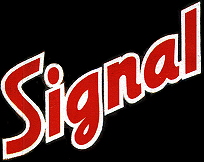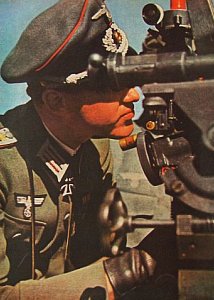
 | Signal. Sonderausgabe der |
|---|
[ Articles ] → Allied Airmen and Signal
Notes on Use of Signal Magazine by Allied Airmen
by Bruce Bolinger
The 6000 Allied airmen shot down over northwestern Europe during World War II who successfully evaded capture and made their way back to England owed their success to many things, sometimes even a copy of Signal magazine. With most of the escape routes requiring travel through the Low Countries and France in order to reach Spain, train travel was a necessity, even though risky. Not only was there the danger of identity checks by police, but other passengers sharing the same train compartment might be an airman's undoing if they tried to engage him in conversation. To keep the airman occupied and discourage unwanted talk, what better than a copy of Signal? Even if he was unable to read the language, he could pretend to and the other passengers might take him to be a collaborator or a German and leave him alone. Here are three examples.
1. 2nd Lt. Tom Applewhite, a bombardier on a B-17, was shot down 11 November 1943, near the Dutch city of 's-Hertogenbosch. He was the only member of the crew not killed or captured. Thanks to the help of an escape line largely made up of members of the Royal Dutch Military Police, the Marechaussees, he was in Brussels in four days. Two more escape lines, both Belgian, had him in Spain by the new year. He reached Gibraltar two months to the day after being shot down. |  The photo which Tom Applewhite remembered appears to have been this color plate from issue number 16/1943. |
2. Sgt. George Duffee, RAF, co-pilot of the Halifax EY-S, was on his first flight, 22 June 1943, when he was shot down near Berlicum east of 's-Hertogenbosch. For several weeks he was hidden at several locations in that region, including a monastery near Nijmegen, where he pretended to be a deafmute French soldier. At the end of August he was taken to the local train station for a trip to Tilburg. While waiting on the platform, a German soldier came up and asked from which platform the 12:07 train was to leave. With the little Dutch he had learned at the monastery, Duffee managed to say, "Platform 8." As Duffee described it later,
"He walked away pleased, but then turned around and looked at me. I took out my pro-German magazine and started to leaf through, very interested. The same magazine proved to be very useful on the train, because no Dutchman would talk to me. I pretended to read every page with interest absorbing it all, and sometimes, with a smile playing on my lips, I pretended to sleep. When we stopped at a station I gave my seat up to a lady who entered. Then I started to again to leaf through the magazine. My eyes seldom wandered from the pages, but I kept one eye on my guide who was in the next compartment."
From then on, helped by the same escape lines as Lt. Applewhite, Duffee reached Gibraltar and was back in England four months after being shot down.
3. James Elliott, a Scotsman and a bomb aimer on a Lancaster, bailed out on 3 November 1943 near the city of Overpelt east of Antwerp. The family in the first house he approached gave him a warm welcome once he said "RAF." Placed on a workers' train to Antwerp, Elliott would write years later that,
"The train journey was important to us, for it introduced and accustomed us to seeing uniformed German troops at close quarters. It was also obviously necessary to take steps to avoid getting involved in conversations with other passengers. This was achieved by feigning sleep or being completely engrossed in reading (...) A current copy of Signal (...) was therefore standard issue for train travel. It was very well illustrated, and full of propaganda directed at the Occupied Countries. In format, if not in content, it was similar to the Picture Post, a popular British magazine of the time."
Elliott reached Gibraltar just in time for New Year's Ball and was back in England on 2 January 1944.
Our thanks to Bruce Bolinger for compiling and submitting these anecdotes. Mr. Bolinger has researched the experiences of Allied airmen in Europe, particularly the story of 2nd Lt. Tom Applewhite, and gives talks on his research. He lives in Nevada City, California.
| Return to top of page | Disclaimer | © 2002 – 2010, Alexander Zöller. |